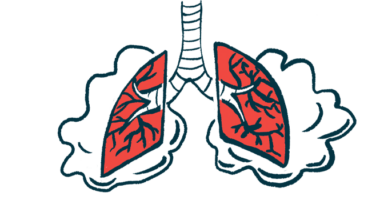Silica Dust Exposure Linked to Worse SSc Symptoms
Most reporting on-the-job silica exposure are men, a study finds

Exposure to silica, a mineral used to make building materials, at work is associated with younger age at diagnosis, more severe disease, and reduced survival in people with systemic sclerosis (SSc), according to a study of more than 1,000 patients in Canada and Mexico.
Also, those reporting on-the-job silica exposure were nearly eight times more likely to be men than women. Exposed male patients were more likely to be Caucasian, smokers, and to have more severe lung disease, while exposed female patients were younger at SSc diagnosis relative to those unexposed.
“Screening for silica exposure among higher risk individuals may be beneficial,” the researchers wrote, adding that “these patients may require closer monitoring for systemic disease.”
The study, “Exposure to silica and systemic sclerosis: A retrospective cohort study based on the Canadian Scleroderma Research Group,” was published in the journal Frontiers in Medicine.
Systemic sclerosis is a chronic autoimmune disease characterized by the accumulation of scar tissue in the skin and several internal organs such as the heart, kidney, lungs, and gastrointestinal tract.
While its underlying causes remain largely unclear, long-term exposure to certain environmental toxins or chemicals are thought to contribute to the disease. Previous studies in Italy and Denmark showed that on-the-job exposure to silica increases the risk of developing SSc and its more severe form, diffuse SSc.
Silica is a mineral that occurs naturally in sandstone and other rocks and is used to make building materials such as glass, bricks, and concrete. When these materials are cut, sawed, or drilled, they release very fine particles of silica dust. Workers who inhale these very fine particles are at an increased risk of developing certain diseases.
“Not surprisingly these occupations commonly employ [males] and males have been consistently shown to exhibit a worse SSc-related prognosis,” the researchers wrote.
Now, a team led by researchers in Canada evaluated the frequency of occupational silica exposure in 1,439 SSc patients (86.7% women) participating in the Canadian Scleroderma Research Group registry and assessed potential links with demographic and clinical features.
All patients, with a mean age at SSc diagnosis of 46.5 years and an average disease duration of 9.83 years, had completed a registry visit at one of the 15 participating rheumatology centers across Canada and Mexico from 2004 to 2019. The Canadian Scleroderma Research Group registry is the largest of Canadian SSc patients.
Results showed that 95 patients (6.6%) reported having worked in hard rock, coal mining, or other occupations where they could have been exposed to silica dust. The proportion of men who reported silica exposure was significantly higher than that of women (22.4% vs. 4.2%).
At first assessment, patients reporting silica exposure were significantly more likely to be men (45.3% vs. 11.1%) and younger at diagnosis (44.9 vs. 47.2 years) than the non-exposed group.
Exposed patients also were more likely to have dcSSc (51.6% vs. 35.3%), and had thicker, more scarred skin, more severe gastrointestinal disease, and more severe interstitial lung disease (ILD). ILD is an umbrella term used to describe a group of diseases in which the lungs become scarred and breathing becomes harder.
When factoring in multiple variables, patients exposed to silica were nearly eight times more likely to be men and 58% less likely to be 50 or older at diagnosis than those reporting no exposure. Silica exposure also was associated with a twofold greater chance of having severe ILD and a 11% greater chance of having severe gastrointestinal disease.
Sex differences also were observed, with exposed women being 60% less likely to be 50 or older at diagnosis compared with non-exposed. Exposed men were 12 times more likely to be Caucasian, had a 5.7 times higher chance of having more severe ILD, and were nearly five times more likely to be smokers than those not exposed to silica.
When the researchers assessed whether exposure to silica predicted a worse disease prognosis, they found that, after adjusting for potential influencing factors, silica-exposed patients had a 50% lower chance of experiencing, for the first time, SSc symptoms and specifically the Raynaud’s phenomenon at ages 50 or older.
Raynaud’s phenomenon is one of the most common and earliest symptoms of scleroderma.
Trends for increased risk of dcSSc, ILD, severe ILD, and worse gastrointestinal disease also were observed, but these failed to reach statistical significance.
Follow-up period
During the study’s follow-up period, more people died in the exposed group than in the non-exposed group (71.4 vs. 43.4 deaths per 1,000 patient-years). Patient-years is a measure of the number of people participating in the study and the amount of time they were followed.
Similar findings were observed when looking at only those whose disease lasted for less than five years (86.1 vs. 41.5 deaths per 1,000 person-years). Men showed higher death rates than women.
Still, when adjusting for potential influencing factors such as age, sex, smoking, and disease duration, there were no significant differences in mortality between the exposed and non-exposed groups.
While on-the-job exposure to silica was reported by the patients themselves, the findings suggest that “prior silica exposure among SSc patients in North America is common, particularly among males and younger females and these patients are at risk of worse outcomes,” the researchers wrote.
However, currently “there is no specific treatment available for SSc associated with silica exposure aside from discontinuing exposure, smoking cessation and SSc management,” they added.
“Earlier diagnosis of SSc could lead to counseling about discontinuation of silica exposure as well as earlier screening for systemic involvement and prompt treatment initiation,” the team wrote.
They also noted that large studies following patients over time and with detailed exposure/occupational questionnaires are needed to further clarify the link between silica exposure and SSc disease course.








